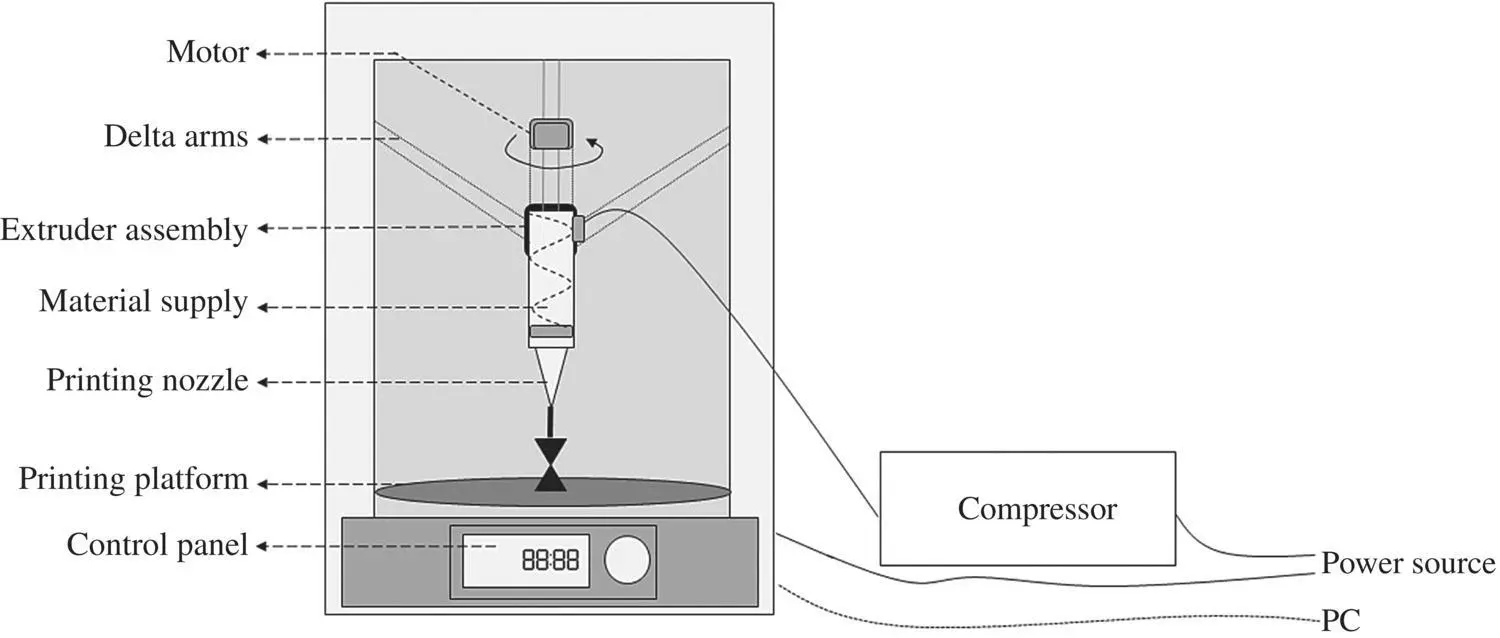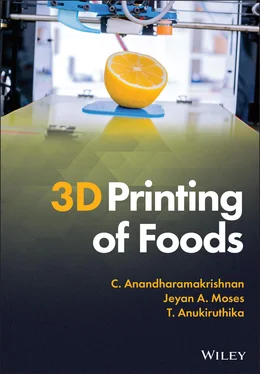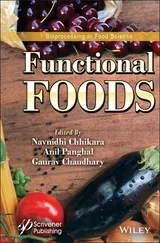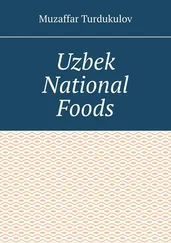C. Anandharamakrishnan - 3D Printing of Foods
Здесь есть возможность читать онлайн «C. Anandharamakrishnan - 3D Printing of Foods» — ознакомительный отрывок электронной книги совершенно бесплатно, а после прочтения отрывка купить полную версию. В некоторых случаях можно слушать аудио, скачать через торрент в формате fb2 и присутствует краткое содержание. Жанр: unrecognised, на английском языке. Описание произведения, (предисловие) а так же отзывы посетителей доступны на портале библиотеки ЛибКат.
- Название:3D Printing of Foods
- Автор:
- Жанр:
- Год:неизвестен
- ISBN:нет данных
- Рейтинг книги:3 / 5. Голосов: 1
-
Избранное:Добавить в избранное
- Отзывы:
-
Ваша оценка:
- 60
- 1
- 2
- 3
- 4
- 5
3D Printing of Foods: краткое содержание, описание и аннотация
Предлагаем к чтению аннотацию, описание, краткое содержание или предисловие (зависит от того, что написал сам автор книги «3D Printing of Foods»). Если вы не нашли необходимую информацию о книге — напишите в комментариях, мы постараемся отыскать её.
Explore the fascinating realm of 3D food printing and its applications 3D Printing of Foods
3D Printing of Foods
3D Printing of Foods
3D Printing of Foods — читать онлайн ознакомительный отрывок
Ниже представлен текст книги, разбитый по страницам. Система сохранения места последней прочитанной страницы, позволяет с удобством читать онлайн бесплатно книгу «3D Printing of Foods», без необходимости каждый раз заново искать на чём Вы остановились. Поставьте закладку, и сможете в любой момент перейти на страницу, на которой закончили чтение.
Интервал:
Закладка:

Figure 2.2 Schematic view of CARK food 3D printer.
Source: Anukiruthika et al. (2020) / With permission of Elsevier.
Another variant of the 3D printing technique used for printing live cell cultures is bioprinting. It involves the process of fabrication of living structures from a cell‐laden bio‐ink. Nowadays, scientists are more interested in the development of in‐vitro cultured meat that has a minimal environmental impact (Post et al. 2020). 3D bioprinting is an ideal means for the construction of cell tissues, scaffolds, and organs. Various AM approaches that are used for 3D bioprinting are extrusion‐based, droplet‐based, and photocuring‐based bioprinting. Among which extrusion‐based 3D printing is widely used for the printing of turkey (Lipton et al. 2010), fish (Chen et al. 2020), beef (Dick et al. 2019b), and pork‐based food products (Dick et al. 2020). Apart from extrusion‐based bioprinting, other approaches like droplet‐based and photocuring must be explored and studied in detail for a better understanding of the state‐of-the‐art of printing of in‐vitro meat. Some of the commercial 3D printers available for bioprinting include 3D Bioplotter, NovoGen MMX Bioprinter™, and Biobot™ (Gu et al. 2019). Advancements in bioprinting for food applications would open up a new dimension of research and remains to offer a promising solution for the shortage of animal‐based meat. Further, 3D printing has a less environmental impact with reduced carbon footprints and overall product life cycles.
Printability refers to the dimensional stability of the material to withstand its own weight (Kim et al. 2018a). So, the success of printability greatly depends on the material composition and printing variables. Food is a complex mixture of macro and micro constituents with varied physiochemical properties (Pérez et al. 2019). The selection of the 3D printing technique is greatly influenced by the type and state of the printing material supply. Some of the material properties are considered specifically based on the type of the printing technique. Properties such as glass transition temperature, powder characteristics, wettability, compressibility, melting and solidification behaviour, viscosity, and crystallinity highly influence the end‐quality and stability of the 3D printed constructs (Nachal et al. 2019). Similar to the product characteristics, process variables such as nozzle size, nozzle height, printing speed, flow rate, motor speed, laser power, and printing temperature must be optimized for the fabrication of seamless 3D construct (Liu and Zhang 2019). Consideration of the material properties and the process variables would vary based on the 3D printing technique used. Some of the common 3D printing technologies that are widely used for food applications have been discussed in the following sections.
2.4 Extrusion‐Based Printing
As stated earlier, material extrusion is based on the FDM approach that is widely used for 3D printing of thermoplastics and polymers. However, for food applications, the same principle has been adapted for layered deposition of food materials that are extruded out through the printing nozzle with precise control over the temperature (Mantihal et al. 2020). The extrusion‐based 3D food printing relies on the continuous flow of material supply either in a semi‐solid paste, highly viscous slurry, or in colloidal form. The solid‐like elastic behaviour of the material supply is ideal for the proper extrusion (Liu et al. 2018a). Hence viscosity is one of the critical factors for the successful deposition of material through extrusion‐based 3D printing. Most of the food materials could be successfully 3D printed using the extrusion technique. However, material consistency is a significant criterion since not all material supplies possess a characteristic solidification behaviour upon extrusion. Considering this issue, the material supply must be pre‐processed adequately to enhance the flow behaviour and its printability (Liu et al. 2019b). The pre‐processing includes the reduction of moisture from the printing material supply either by drying or by concentration. Based on the printability, the food materials are categorized as printable, non‐printable, and alternative ingredients. The characteristic extrudability of non‐printable and alternative ingredients can be improved through the addition of food hydrocolloids such as xanthan gum, guar gum, acacia gum, and sodium alginate as an additive into the printing material supply (Gholamipour‐Shirazi et al., 2019). Material properties such as gelatinization, gelation, and emulsification are the basic mechanisms that support the stability of the printed layers in extrusion‐based 3D printing.
2.4.1 Working Principle, System Components, and Process Variables
Although a range of 3D printing technologies is available for printing foods, extrusion is the commonly used technique due to its simpler design, versatility, flexibility, and scale‐up for commercial applications (Beg et al. 2020). Extrusion is the process of forcing the solid/semi‐solid/liquid materials through a smaller aperture thereby forming the desired shape with desired cross‐sections. A typical extrusion‐based 3D printer consists of a feed supply unit, extruder assembly, extrusion motor, pneumatic assembly, and a microprocessor controller unit ( Figure 2.3). The 3D printing process starts with the material loading into the feed supply system followed by pushing the material through the extruder assembly via printing nozzle in a controlled manner.

Figure 2.3 Schematic diagram of typical extrusion‐based 3D printing.
The movement of the printing arms and coordinate axes are controlled by a microprocessor unit in a pre‐defined tool path (Guo et al. 2019b). Thus, the successively deposited layers are bonded together and get solidified forming a coherent stable solid 3D structure. Based on the extrusion mechanism, the extrusion unit can be of either a screw‐based extrusion, syringe‐based extrusion, pneumatic driven extrusion, or a combined mechanism (Portanguen et al. 2019) ( Figure 2.4).
In the first type of screw‐based feeding system, a programmed screw‐driven motor assists in the continuous pushing of the material through the printing nozzle. While in a syringe‐based extrusion unit, a plunger is driven by the programmed stepper motor that assists in the extrusion of material through the nozzle in a linear motion. The syringe‐based extrusion system is more common for food printing applications that are easy and convenient for a small batch of samples. However, for large‐scale applications, a continuous flow of material is required which can be possible with the screw‐driven system (Guo et al. 2019a). As an added advantage, screw‐driven extrusion results in simultaneous mixing as well as extrusion of the material. This combined unit operation ensures proper consistency and the continuous flowability of the material supply that would otherwise result in nozzle blocking as in the case of a syringe‐based extrusion unit. On the other hand, the pneumatic assisted extrusion unit is almost similar to that of the syringe‐based system with the replacement of the syringe with the plunger in cartridge that is pushed by the air pressure using a pneumatic compressor unit. The screw‐based extrusion unit is not suitable for materials with high viscosity and mechanical strength (Liu et al. 2018a). For those samples with high viscosity, a syringe‐based extrusion mechanism is used for achieving proper extrusion and good precision. While the pneumatic‐based air pressure‐driven extrusion is more suitable for printing low viscosity liquid samples (Sun et al. 2018b). Although extrusion‐based 3D printing has a great scope and applicability for printing foods, the printing of delicate complex shapes is very challenging. The extrusion‐based 3D constructs are more prone to structural collapse and deformation that requires additional support for stable product geometry which must be removed after 3D printing process (Liu and Zhang 2019). In case of polymer printing, the removal of additional support structures is easy, however, for food applications it greatly affects the final resolution of the printed 3D construct. Hence, more studies on material properties and post‐stability behaviour are required for deeper understanding of the food printing technologies.
Читать дальшеИнтервал:
Закладка:
Похожие книги на «3D Printing of Foods»
Представляем Вашему вниманию похожие книги на «3D Printing of Foods» списком для выбора. Мы отобрали схожую по названию и смыслу литературу в надежде предоставить читателям больше вариантов отыскать новые, интересные, ещё непрочитанные произведения.
Обсуждение, отзывы о книге «3D Printing of Foods» и просто собственные мнения читателей. Оставьте ваши комментарии, напишите, что Вы думаете о произведении, его смысле или главных героях. Укажите что конкретно понравилось, а что нет, и почему Вы так считаете.










